Extended Version: Jane Goodall on 60+ Years of Conservation and Research
Published: July 15, 2020
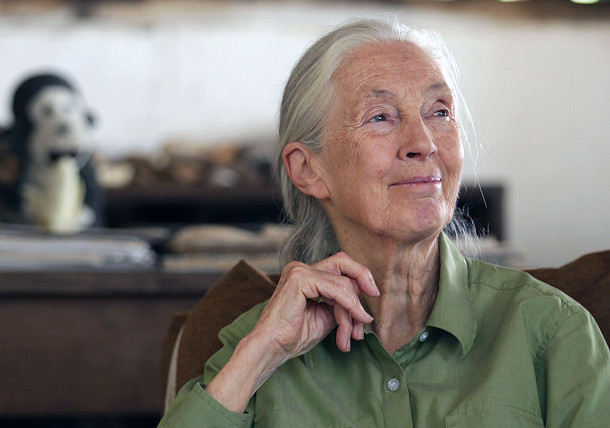
Through her speaking engagements and her Roots & Shoots program, Jane has inspired people from all over the world. (Photo: Simon Fraser University - Communications & Marketing, Flickr, CC BY 2.0)
(stream/download) as an MP3 file
The iconic Jane Goodall has spent her life advocating for the conservation of the natural world. Sixty years ago on July 14th, 1960, Jane arrived in what is now Gombe National Park, Tanzania, to begin her groundbreaking research on chimpanzees. In this extended interview version, Jane Goodall joins Steve Curwood to discuss her career studying chimps, the work her organization is doing now, what we can learn about our relationship with the natural world from the current pandemic, and much more.
CURWOOD: Hi, I’m Steve Curwood and today on the Living on Earth Podcast we’ll have a chat with pioneering primatologist and conservationist, Jane Goodall about how she first followed her dream into the forests of East Africa to study chimpanzees 60 years ago this week.
But first, your support helps make it possible to bring you this podcast, so please contribute what you can.
Five dollars or more makes a difference.
You can donate right now at LOE.org and thanks!
[THEME]
CURWOOD: It’s Living on Earth, I’m Steve Curwood.
On July 14th, 1960, at the age of 26 Jane Goodall arrived in what is now Gombe National Park, Tanzania, to begin her breakthrough study of wild chimpanzees. Along the way she realized that if there were going to be chimps in the future she had best speak out on their behalf as well as for the forests and their human stewards. The last time I spoke with Jane, in 1993, we discussed her book Visions of Caliban, co-authored with Dale Peterson. And on the sixtieth anniversary of her arrival at her research site her study still continues. Jane Goodall joins us now from her home in England. Welcome back to Living on Earth!
GOODALL: Thank you for inviting me back.
CURWOOD: The last time we talked with you and your co-author at the time, Dale Peterson, the book "Visions of Caliban," you discuss the ways that chimps and humans are similar and different. One of the similar things was the laugh, but I didn't learn to do the greeting that time. Could I have a lesson now on the greeting, the chimp greeting?
GOODALL: It's appropriate because this is the distance greeting, and we are at a distance and most people listening are all scattered all over the place. And this is the call that a chimpanzee identifies him or herself with, they all have a slightly different one. We call it the pant-hoot. And it's [chimpanzee sounds]
CURWOOD: Okay, so, now that's for Jane Goodall. So what would a Steve Curwood say?
GOODALL: Well you just do it a bit deeper, but the main thing is it's all one breath. It's like a dog panting. You can put your own sound in it.
CURWOOD: [chimpanzee sounds]
GOODALL: Okay, slightly odd ending but apart from that very good.
CURWOOD: [chimpanzee sounds]
GOODALL: [laughs]
CURWOOD: So, we're celebrating now the 60th anniversary of your arrival to what is now what, Gombe National Park in Tanzania.
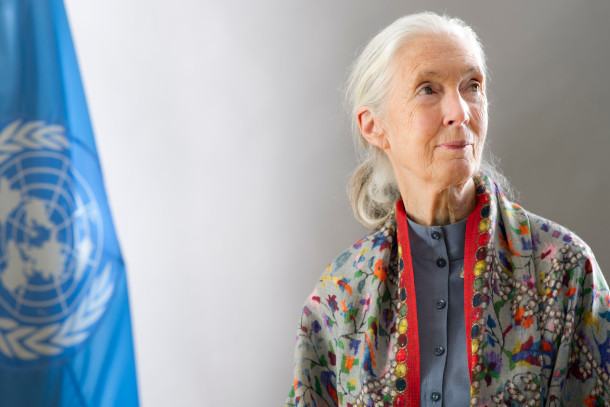
Jane Goodall has served as a United Nations Messenger of Peace since 2002, helping the UN tackle environmental issues. (Photo: United Nations Photo, Flickr, (CC BY-NC-ND 2.0)
GOODALL: Yeah.
CURWOOD: Take me back to that very first day. How did you feel when you stepped into the forest there?
GOODALL: Well, going along the lake, you know, it's on the edge of Lake Tanganyika, and I was looking up at the thickly forested hills, and it looked so big and I was thinking, you know, how am I going to find them? But, so we got there, got to the camp, put up a tent, and then it was getting towards evening when I nipped up the opposite slope a little way by myself, and I sat there looking out over the lake through these trees, and a troop of baboons came by and I heard a bushbuck barking and it was like, this is my dream come true. I'm in paradise. It was truly magic. And I wanted to go to Africa from the age of 10. I met Louis Leakey, he gave me this amazing opportunity to study chimpanzees. And, how amazing it was chimpanzees, you know, the most fascinating creature to study. Because fortunately, chimpanzees are so biologically like us that we share 98.6% of our DNA with them. Then, of course, as the days and weeks and months went by, the chimps were still running away from me, and I knew that with time I could get their trust, but there was only money for six months. But, you know, fortunately, the one who began to lose his fear demonstrated that chimpanzees can use and make tools, something which Western science decided only humans could do. And so that brought in National Geographic Society, they sent a photographer/filmmaker Hugo Van Lawick. And when the reports of what I was observing, and his pictures and film were circulating, the scientists just had to give up. They could no longer say, "Oh, why should we believe her? She's just a girl." And so then I was able to confront the professors when Leakey sent me to Cambridge, when they told me I'd done everything wrong. I couldn’t talk about chimpanzees having personalities, minds, or emotions, because those were unique to humans.
CURWOOD: Your toolmaking friend - talk to me about his name and why you picked it.
GOODALL: Well, David Greybeard had this beautiful white beard. Now, why David Greybeard, I don't know. The chimps just got names. I was told I should have numbered them by the scientists, but they all have their own personalities. They can all have feelings - happiness, sadness, fear, despair, grief. They have a territory, they patrol the territory, they can engage in a kind of primitive war. They also show compassion and true altruism as when an adult male will adopt a motherless orphan even though that child is not related.
CURWOOD: So, you not only got the attention of the scientific world, but you fell in love as well!
GOODALL: Fell in love with Hugo, and we married, and we had our son, who’s been on lockdown in the UK. He came for two weeks to get a visa, and he’s still here.
CURWOOD: Well you can’t exactly go back to East Africa yourself right now, can you?
GOODALL: No, no, I’ve been here for the duration. And um, Tanzania is a nightmare right now. We don’t even know how many cases there are, the President says that it’s defeated and gone away -
CURWOOD: Not true, not true.
GOODALL: The truck drivers who’ve been tested when they come to the border with Uganda and Kenya, if they test positive they’re sent back, and a lot are being sent back.
CURWOOD: So, one of the special things about your story, of course, is that you have your mother with you at times, and you, you also have your son with you at times, which is a different perspective than many scientists have.
GOODALL: My first trip to Africa was in 1957. I was on my own. That was pretty amazing, back then I was 23 which is about like a 16 year old today - I would say we were very naive. There was no students going off overseas like there is now. It was just, you know, the young men went on the world tour, the grand tour it was called, usually with a tutor or something. Mom let me go off on this boat; there were no planes going back and forth then, and you know, that was, that trip was when I met Louis Leakey. But something special happened on that trip. The first place we set foot on African soil was Cape Town. Normally you’d go through the Suez Canal from London but there was a war with Egypt and it was closed. So, it was a whole month and, the first place was Cape Town. It was very exciting, there I was, I was in Africa, and of course it’s beautiful. But then I kept seeing this writing on the backs of the seats and the doors to the restaurants; “Slegs blankes, slegs blankes.” And I said, “what do these words mean in Afrikaans?”... “White people only.” And, I wasn’t brought up that way. My grandfather was a congregational minister. We didn’t judge people by the color of their skin or their nationality. And, once I knew that, I couldn’t wait to get away from Cape Town. Kenya was much better, it was just on the brink of independence and, as was Tanzania. So, but, you know, it was quite a, quite a shock to me to arrive in Cape Town and come face to face with apartheid.
CURWOOD: Indeed.
GOODALL: But anyway, so I, you know, it was when I went back the second time when, once Leakey got money for me to study the chimps, the British Authority, Tanzania, was still part of the crumbling British Empire on its last legs, and they said no, we're not taking responsibility for a young girl on her own, she must come with somebody. And so my mother volunteered. And it was amazing because she was there; one, she set up a little clinic for the local fishermen, and that started right from the beginning a really good relationship with the local people. And secondly, when I was depressed in those first months, when the chimps ran away from me, she would be there in the evening, pointing out that actually I was learning more than I thought. I found this peak, and with my binoculars, I could see how the chimps were making nests at night. I could hear their calls, I could see what they were eating. I could see how they traveled around in different size groups, and sometimes all of them got together when it was the new fruit, ripe in season, with lots of excitement and charging about. So, then of course, David Greybeard, and it was so sad - that happened just two weeks after she left, and I had nobody to share this excitement with. I mean, I had a cook and a boat driver and they were, they were very happy to hear, but they couldn’t see why it was so exciting. [laughs]
CURWOOD: [laughs] And then, going ahead, what was it like to have your son with you?
GOODALL: If he was at Gombe, he was always with somebody. And we built a house down on the lakeshore where the chimps seldom go. But I spent a lot of time then with Hugo on the Serengeti, and Ngorongoro Crater, where our precious little son was safe. Safer, anyway. His first words, he never spoke until he could say a sentence. And, his first sentence was, “Big lion out there eat me.” [laughs]
CURWOOD: [laughs] He was aware, definitely aware. You had this wonderful tool documentation breakthrough, as a woman scientist, that of course, put the wind under your wings and allowed you to move forward. But what would you say to women scientists today who, I'm afraid to say, often run into an awful lot of opposition themselves?
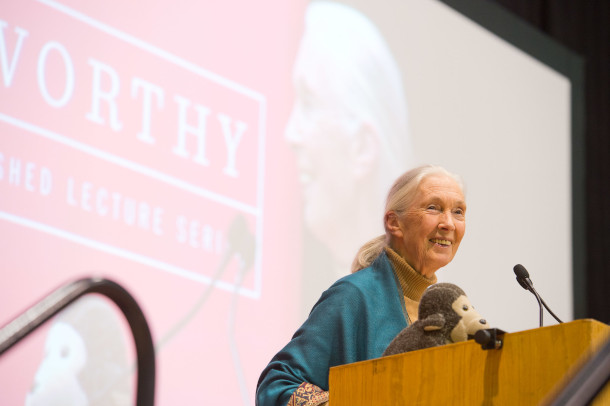
Jane normally travels the world 300 days a year, sharing her story and inspiring future generations of environmentalists. (Photo: The University of Winnipeg, Flickr, (CC BY-NC-ND 2.0)
GOODALL: Well, I always say, you know, whether you're male or female, if you want to do science, a particular branch of science, first of all, you've got to really want to do it because there's competition. It doesn't matter what sex you are, or what color your skin is, there's competition to get into a lot of these fields. So you've got to really work hard and do as well as you possibly can, so that at least academically you can compete on an equal footing. And there's much, much less discrimination against women now than there was back in the, in the early 60s when I began. But you see I was lucky. There was, there was nobody to compete with because nobody else was doing it. It was just me.
CURWOOD: So there was a pivotal moment in your life Jane when you traveled from Gombe to a conference as a researcher, and as you say, you left as an activist. Tell me about that moment, please.
GOODALL: I helped to put that conference together. It was four days in Chicago, and it was the first time the different chimp researchers from different fields sites in Africa came together because by then there was six other field sites. And, it was mainly to see how chimp behavior differed from environment to environment, or didn't differ as the case may be. But we had a session on conservation, and we had a session on conditions in some captive situations like medical research labs, and it was a shock. I knew there was deforestation, I had no idea the extent of it. I had no idea the speed with which chimp numbers were decreasing. And, I certainly had no idea about what went on in the medical research labs, so I just left as an activist; I didn't make a decision. I went as a scientist, I left as an activist. And, first thing I had to do was make myself go into those labs because you've got to see it firsthand. And it's been a long battle, but finally with others helping, you know, we have got chimps out of medical research. And then Africa, I learned about the plight facing so many of the African people living in and around chimpanzee habitat. And flying over Gombe, which in 1960 and 70, was part of this great equatorial forest belt that stretched right over from Western East Africa to the west coast. And when I flew over in 1990, it was just this little island of trees surrounded by completely bare hills. People struggling to survive, more than the land could support, too poor to buy food from elsewhere. And you know, this is when it hit me. If we don't help them find ways of making a living without destroying the environment, then we can't even try to save the chimpanzees. So that's where we began our take care, Tacare, program, which is our method of community-based conservation.
CURWOOD: So how does the Tacare program help both local communities and conservation?
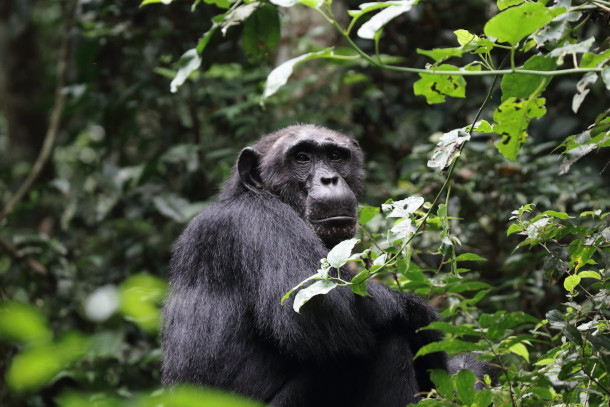
Perhaps Goodall’s most famous discovery was that chimpanzees can make and use tools, which changed the way humans think about other animals. (Photo: NH53, Flickr, CC BY 2.0)
GOODALL: Well, we've introduced microcredit based on Muhammad Yunus' Grameen Bank. So the women, particularly the women, take out tiny loans for their own environmentally sustainable projects, like getting a few chickens, selling the eggs, having tree nurseries; sometimes a slightly bigger project like shade grown coffee plantation or pineapples, something like that. And because it's not just a grant given to them, but it's a loan, when they pay it back, and they do, now it's theirs. They've done it by their own hard work. It started with 12 villages around Gombe. It's now in 104 throughout the whole of chimp range. Protecting the forest is for their own future, not only for the wildlife, because they need the forest for shade, for temperature regulations, for clean air and clean water and to prevent erosion.
CURWOOD: Now, what about your youth program that you started, I think you called it Roots and Shoots?
GOODALL: Roots and Shoots.
CURWOOD: Yeah. How did that come about? And tell me more about it.
GOODALL: It came about because when I was traveling, raising awareness about what was going on in Africa and also raising money for Tacare and chimp research, I was meeting young people who seemed to have lost hope. And they told me they felt depressed or apathetic or angry, because we've compromised their future, and there's nothing they can do about it. Well, we have compromised their future. In fact, we've been stealing it. But I didn't think it was true, there was nothing that they could do. So it all began with 12 high school students visiting me at my home in Dar es Salaam, capital of Tanzania. And we decided the main message would be: every single one of us makes some impact on the planet every single day, and we get to choose what sort of impact we make. And we decided that because in the rainforest, you learn how everything is interconnected, and every little species has a role to play, just as we all do, that every group would choose for themselves three projects: one to help people, one to help animals, one to help the environment. And because they get to choose it, they're passionate. Well, it's now in more than 86 countries, and it's got hundreds of thousands of groups. It's got members in kindergarten, university, everything in between. We've even got adult groups now. We've got a whole batch of people who've been through the program in youth, and they seem to hang on to the values. And part of this is understanding that much more important than our nationality, our language, our culture, our religion, the color of our skin, our food preferences, more important than all of that, is the fact that we're one human family. Our blood is the same if we hurt ourselves, our tears are the same, our laughter's the same. And that is something which we need so desperately today.
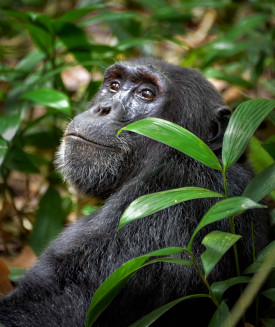
Jane Goodall discovered that chimpanzees are omnivorous, can wage war, have strong mother/infant bonds, and show acts of compassion. (Photo: Rod Waddington, Flickr, CC BY-SA 2.0)
CURWOOD: So Jane Goodall, you helped inspire so many young people through your work. How do you feel when you see now millions of young people beginning to stand up and talk about environmental issues?
GOODALL: It's wonderful, and it's not that they can change the world, they are changing the world. And you know, Roots and Shoots, yes, we do join marches and demonstrations, peaceful ones, but it's mainly about rolling up your sleeves and taking action, working out what you can do. And there's always some people passionate to help animals, to stop trafficking, for example, which is how we got the pandemic - one of the main reasons - or trying to fight factory farms or volunteering in shelters for dogs, stray dogs and cats. There’s always people who want to help people, and volunteer in soup kitchens and so on. And there’s always people who want to help the environment, and plant trees and grow organic vegetables and - the, the imagination of young people is fantastic.
CURWOOD: So let's talk about what's going on right now, this pandemic and its connection to wildlife trafficking. What does this moment tell us?
GOODALL: Well, this moment tells us that we brought this entire pandemic on ourselves. The scientists studying these zoonotic diseases, those are the ones that jump from an animal to a person, have been telling us for a long time this pandemic was coming, and it won't be the last. And it's entirely because of our disrespect for animals and the natural world. So we cut down the forests, we're pushing animals in closer contact with people, animals are being trafficked, and many of them from different parts of Asia and even from Africa, are ending up in the wildlife meat markets in Asia in horrible, unhygenic conditions. And they're stacked in tiny cages, it's horrifically cruel, and the vendor and the buyer, either of them can be contaminated with blood, urine, feces. And in this sort of environment, it's the perfect opportunity for a virus or a bacteria to jump from an animal to a person. And if that binds with a cell in the human body, it might form a new disease and that disease might be contagious to other humans, as is the case with COVID-19. But, you know, it's also the conditions that we put animals in when we farm them intensively, these factory farms, and diseases have started there, jumping from an animal, a pig or a cow, to a human. So it's our fault. It's our disrespect. Here are we, the most intellectual creature that's ever walked the planet, so how come that we're destroying our only home? And we are destroying our only home very fast. We'll come out of this pandemic. We've come out of previous ones like the Black Death, but we're going to be left to face, to confront, the real existential challenge of our time, which is climate change. It was Mahatma Gandhi who said, the planet can provide for human need, but not human greed. We've become very greedy as we become more and more materialistic, and less and less having any spiritual connection with the natural world.
CURWOOD: So Jane, what are your reasons for hope?
GOODALL: Well, first of all, as I've said, it's the young people because they are changing the world. Secondly, this extraordinary brain - now we haven't used it wisely - but science is beginning to come up with really innovative technologies that will enable us to live in greater harmony with nature, and we're using our own individual brains to think about our own individual environmental footprints. I've been a vegetarian ever since the late 60s when I learned about these factory farms. And so, by not eating meat, and by increasingly turning to a plant-based diet - when I'm at home here now, I'm vegan - but it can make a huge difference. Anybody who wants to know one thing: eat less meat, or no meat. If we all make ethical choices every day, if we, if we ask about the consequences of the choices we make; where did it come from? Did it harm the environment? Was it cruel to animals? So if we make ethical choices, it'll make a big difference. And then there's the resilience of nature. I talked about the bare hills around Gombe, and there's no bare hills anymore. The trees are back. Leave the land, give it a chance, nature reclaims. Animals on the brink of extinction can be given another chance. And then there's the indomitable human spirit. The people who won't give up, they tackle what seems impossible.
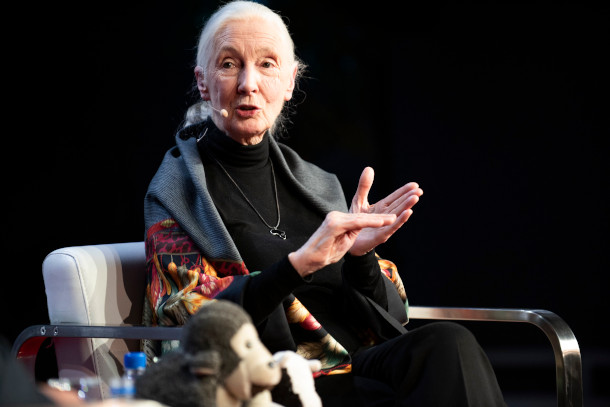
At 86 years old, Jane is still a tireless advocate for people, animals, and the environment. (Photo: Milken Institute, Flickr, CC BY-NC 2.0)
CURWOOD: Um, what's next for Jane Goodall?
GOODALL: I'm going to carry on, I'm going to grow Roots and Shoots, I'm going to visit more countries. I can just go and try and inspire the right people. Because, you know, I’m too old to go off and do things like I - I wanted to go and climb the distant mountains in Papua New Guinea and go into the, you know, the high mountains of North Korea to see the nesting cranes. And, I know I won’t do those things now, because, well I won’t. Bodies get older. I’m very grateful to my body. It takes me around, it doesn’t let me down.
CURWOOD: So, here it is, 60 years later, what are you doing to celebrate this momentous anniversary?
GOODALL: Ha! We had so many plans that was going to be, you know, going to all the different Jane Goodall Institutes, in 24 countries now, and having galas, raising awareness, raising funds. Well, COVID-19's put that all on hold, so we're doing, you know, we're doing it virtually. I've done a reading of "In the Shadow of Man," which is the first book I did, all those early days. And we're putting a whole lot of photos which have never before been seen to illustrate it. And we'll be having, you know, events online.
CURWOOD: So, of course, you not only conducted research on chimpanzees and inspired, let's face it, the next generations of environmental activists, but, you know, you're usually on the road, what, 300 days a year to spread the message - so what keeps you motivated?
GOODALL: Because I care passionately about the environment. I care about animals. I care about children. Because I'm obstinate, you know, do you think I'm going to let the Donald Trumps and Bolsonaros and people like that knock me down and keep me down? No, I'll go on fighting till the day I die. Because I'm passionate, and because I believe we have a window of time. And you know, if everybody loses hope, if people think, well as some scientists say, you know, on the downward path, we can't do anything anymore. Well, then nobody will do anything, will they? So that's, that's what people, young people tell me and I'm going around the world, you know, well you've given me hope, I promise I'll do my bit. And it's only if we all do our bit and get together, that we can start slowing down climate change, heal some of the harm that we've inflicted.
CURWOOD: Conservationist Jane Goodall is founder of the Jane Goodall Institute and a UN Messenger of Peace. Thanks so much for taking this time with us.
GOODALL: Thank you very much.
[MUSIC]
CURWOOD: To get the stories behind the stories on Living on Earth as well as special updates please sign up for the Living on Earth newsletter.
Every week you’ll find out about upcoming events and get a look at show highlights, and exclusive content.
Just navigate to the Living on Earth website loe.org and click on the newsletter link at the top of the page.
That’s loe.org.
[MUSIC]
CURWOOD: Living on Earth is produced by the World Media Foundation. Our crew includes Naomi Arenberg, Bobby Bascomb, Paloma Beltran, Jenni Doering, Jay Feinstein, Anne Flaherty, Don Lyman, Isaac Merson, Aynsley O’Neill, Jake Rego, Kori Suzuki, and Jolanda Omari. Today a fond farewell and special thanks to Thurston Briscoe, a fine gentleman and radio guru who is retiring. We will miss you, Thurston! Tom Tiger engineered our show. Alison Lirish Dean composed our themes. You can hear us anytime at L-O-E dot org, Apple Podcasts and Google Podcasts, and like us, please, on our Facebook page - Living on Earth. We tweet from @livingonearth. And find us on Instagram at livingonearthradio. I’m Steve Curwood. Thanks for listening!
ANNOUNCER: Support for Living on Earth comes from Sailors for the Sea and Oceana. Helping boaters race clean, sail green and protect the seas they love. More information at sailors for the sea dot org.
ANNOUNCER 2: PRX.
Links
The Jane Goodall Institute’s Official Website
Roots & Shoots, an initiative of the Jane Goodall Institute
Discovery, Innovation & Hope: Honoring the Global Impact of Gombe and Jane Goodall
The Jane Goodall Institute | “Gombe: Nearly 60 Years of Discovery”
Living on Earth wants to hear from you!
Living on Earth
62 Calef Highway, Suite 212
Lee, NH 03861
Telephone: 617-287-4121
E-mail: comments@loe.org
Newsletter [Click here]
Donate to Living on Earth!
Living on Earth is an independent media program and relies entirely on contributions from listeners and institutions supporting public service. Please donate now to preserve an independent environmental voice.
NewsletterLiving on Earth offers a weekly delivery of the show's rundown to your mailbox. Sign up for our newsletter today!
 Sailors For The Sea: Be the change you want to sea.
Sailors For The Sea: Be the change you want to sea.
 The Grantham Foundation for the Protection of the Environment: Committed to protecting and improving the health of the global environment.
The Grantham Foundation for the Protection of the Environment: Committed to protecting and improving the health of the global environment.
 Contribute to Living on Earth and receive, as our gift to you, an archival print of one of Mark Seth Lender's extraordinary wildlife photographs. Follow the link to see Mark's current collection of photographs.
Contribute to Living on Earth and receive, as our gift to you, an archival print of one of Mark Seth Lender's extraordinary wildlife photographs. Follow the link to see Mark's current collection of photographs.
 Buy a signed copy of Mark Seth Lender's book Smeagull the Seagull & support Living on Earth
Buy a signed copy of Mark Seth Lender's book Smeagull the Seagull & support Living on Earth

